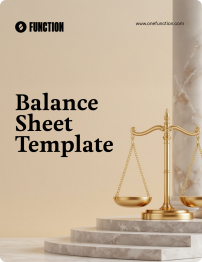onefunction.com
TEMPLATE
Balance Sheet Template
Download the Balance Sheet Template
Enter your details for instant access.
Turn your financial data into a clear snapshot of your business's value. Built in Google Sheets to show exactly what your business owns and owes—at a specific point in time.

By clicking ‘Get Started’, I agree to Functions’s Terms & Privacy Policy.
What is a Balance Sheet?
Your balance sheet shows:
A balance sheet is a snapshot of your business’s financial position at a specific point in time. It’s one of the three essential financial statements (alongside your income statement and cash flow statement) that shows what you own (assets), what you owe (liabilities), and your stake in the business (equity).
Whether you're applying for a loan, planning a big decision, or reviewing performance, your balance sheet answers the question: "What is my business worth right now?"
Successful businesses check their balance sheet regularly to manage risk, monitor performance, and make smarter financial decisions.
Total value of everything your business owns
All debts and obligations your business owes
Your actual ownership stake in the business
Whether you're in a strong position to grow, invest, or borrow
The numbers banks and investors look for
Balance Sheet Format: A Simple Breakdown of Your Business Value
Assets
Liabilities
Equities
What your business owes to others.
Current Liabilities (due within a year):
- Accounts payable (bills you owe)
- Credit card balances
- Short-term loan payments
- Payroll and tax obligations
- Unearned revenue (customer prepayments)
Long-term Liabilities
- Business loans
- Mortgages
- Equipment financing
- Long-term lease obligations
Everything your business owns that has value.
Current Assets (convertable to cash within a year):
- Cash in bank accounts
- Accounts receivable (money customers owe you)
- Inventory you can sell
- Prepaid expenses (like insurance)
- Long-term Assets:
Equipment and machinery
- Buildings and land
- Company vehicles
- Long-term investments
- Intangible assets (patents, trademarks)
Your stake in the business—what’s left after subtracting liabilities from assets.
- Owner’s investment
- Retained earnings
- Additional capital from partners or investors
- Profit or loss for the current year
The Formula That Matters
Assets = Liabilities + Equity
This formula is the foundation of your balance sheet. It ensures everything is accounted for—what your business owns must equal what it owes and what’s been invested.
Example:
Assets: $100,000 = Liabilities: $60,000 + Equity: $40,000
If your assets go up and your liabilities go down, your equity grows—showing a healthier business.
How This Balance Sheet Template Works
1. Set up your categories in the Chart of Accounts sheet:
- List your asset accounts (cash, inventory, equipment)
- Add your liability accounts (loans, credit cards, bills)
- Include equity items (owner's investment, retained earnings)
2. Enter your transactions
- Enter each transaction
- Add the date, a clear description of the item or service
- Select a category from the dropdown menu
- Record the amount paid or received
3. Generate your balance sheet
- Enter the reporting start date
- The sheet calculates totals automatically
- View your assets, liabilities, and equity in one place
- Share the report with investors, lenders, or your team
The template automatically ensures your assets equal your liabilities plus equity.
info@onefunction.com
(305) 322-4561